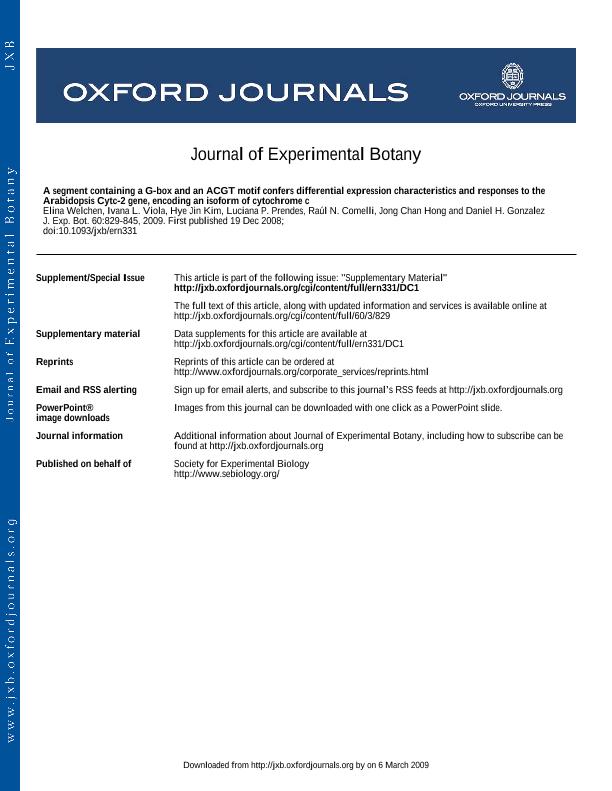Mostrar el registro sencillo del ítem
dc.contributor.author
Welchen, Elina

dc.contributor.author
Viola, Ivana Lorena

dc.contributor.author
Kim, Hye Jin
dc.contributor.author
Prendes, Luciana Paola

dc.contributor.author
Comelli, Raul Nicolas

dc.contributor.author
Hong, Jong Chan
dc.contributor.author
Gonzalez, Daniel Hector

dc.date.available
2023-01-31T14:31:30Z
dc.date.issued
2009-03
dc.identifier.citation
Welchen, Elina; Viola, Ivana Lorena; Kim, Hye Jin; Prendes, Luciana Paola; Comelli, Raul Nicolas; et al.; A segment containing a G-box and an ACGT motif confers differential expression characteristics and responses to the Arabidopsis Cytc-2 gene, encoding an isoform of cytochrome c; Oxford University Press; Journal of Experimental Botany; 60; 3; 3-2009; 829-845
dc.identifier.issn
0022-0957
dc.identifier.uri
http://hdl.handle.net/11336/186292
dc.description.abstract
Sequences required for the expression of Cytc-2 (At4g10040), one of two cytochrome c genes from Arabidopsis thaliana, were characterized using plants transformed with deleted and mutagenized promoter fragments fused to gus. These studies indicated that a region containing a G-box and an ACGT motif is essential for expression. Mutation of the ACGT motif causes a complete loss of expression, while mutation of the G-box causes decreased expression in aerial parts and abolishes expression in roots and induction by environmental factors. Upstream located site II elements are required for maximal expression, mainly in reproductive tissues, and maximal induction by different factors. One-hybrid screenings allowed the identification of transcription factors from the bZIP and bHLH families that interact mainly with the G-box. Four of these factors were able to bind to the Cytc-2 promoter in vitro and in transactivation assays in Arabidopsis. Analysis of available microarray data indicated that the bZIP transcription factors share expression characteristics with the Cytc-2 gene, suggesting that they act as mediators of its response to tissue-specific, environmental, and metabolic conditions. Site II elements interact with a TCP family protein and may co-ordinate the expression of the Cytc-2 gene with that of other respiratory chain components. A model is proposed for the evolution of the Cytc-2 gene through the incorporation of a segment containing a G-box and an ACGT motif into an ancestral gene that contained site II elements. This may have reduced the importance of site II elements for basal expression and conferred new responses to environmental factors.
dc.format
application/pdf
dc.language.iso
eng
dc.publisher
Oxford University Press

dc.rights
info:eu-repo/semantics/openAccess
dc.rights.uri
https://creativecommons.org/licenses/by-nc-sa/2.5/ar/
dc.subject
ARABIDOPSIS THALIANA
dc.subject
CYTOCHROME C
dc.subject
MITOCHONDRION
dc.subject
PROMOTER ANALYSIS
dc.subject.classification
Bioquímica y Biología Molecular

dc.subject.classification
Ciencias Biológicas

dc.subject.classification
CIENCIAS NATURALES Y EXACTAS

dc.title
A segment containing a G-box and an ACGT motif confers differential expression characteristics and responses to the Arabidopsis Cytc-2 gene, encoding an isoform of cytochrome c
dc.type
info:eu-repo/semantics/article
dc.type
info:ar-repo/semantics/artículo
dc.type
info:eu-repo/semantics/publishedVersion
dc.date.updated
2021-12-13T18:52:56Z
dc.journal.volume
60
dc.journal.number
3
dc.journal.pagination
829-845
dc.journal.pais
Reino Unido

dc.journal.ciudad
Oxford
dc.description.fil
Fil: Welchen, Elina. Universidad Nacional del Litoral. Facultad de Bioquímica y Ciencias Biológicas. Departamento de Ciencias Biológicas. Cátedra de Biología Celular y Molecular; Argentina. Consejo Nacional de Investigaciones Científicas y Técnicas. Centro Científico Tecnológico Conicet - Santa Fe. Instituto de Agrobiotecnología del Litoral. Universidad Nacional del Litoral. Instituto de Agrobiotecnología del Litoral; Argentina
dc.description.fil
Fil: Viola, Ivana Lorena. Universidad Nacional del Litoral. Facultad de Bioquímica y Ciencias Biológicas. Departamento de Ciencias Biológicas. Cátedra de Biología Celular y Molecular; Argentina. Consejo Nacional de Investigaciones Científicas y Técnicas. Centro Científico Tecnológico Conicet - Santa Fe. Instituto de Agrobiotecnología del Litoral. Universidad Nacional del Litoral. Instituto de Agrobiotecnología del Litoral; Argentina
dc.description.fil
Fil: Kim, Hye Jin. Gyeongsang National University; Corea del Sur
dc.description.fil
Fil: Prendes, Luciana Paola. Universidad Nacional del Litoral. Facultad de Bioquímica y Ciencias Biológicas. Departamento de Ciencias Biológicas. Cátedra de Biología Celular y Molecular; Argentina. Consejo Nacional de Investigaciones Científicas y Técnicas; Argentina
dc.description.fil
Fil: Comelli, Raul Nicolas. Gyeongsang National University; Corea del Sur
dc.description.fil
Fil: Hong, Jong Chan. Gyeongsang National University; Corea del Sur
dc.description.fil
Fil: Gonzalez, Daniel Hector. Universidad Nacional del Litoral. Facultad de Bioquímica y Ciencias Biológicas. Departamento de Ciencias Biológicas. Cátedra de Biología Celular y Molecular; Argentina. Consejo Nacional de Investigaciones Científicas y Técnicas. Centro Científico Tecnológico Conicet - Santa Fe. Instituto de Agrobiotecnología del Litoral. Universidad Nacional del Litoral. Instituto de Agrobiotecnología del Litoral; Argentina
dc.journal.title
Journal of Experimental Botany

dc.relation.alternativeid
info:eu-repo/semantics/altIdentifier/url/https://academic.oup.com/jxb/article/60/3/829/447347
dc.relation.alternativeid
info:eu-repo/semantics/altIdentifier/doi/http://dx.doi.org/10.1093/jxb/ern331
Archivos asociados
